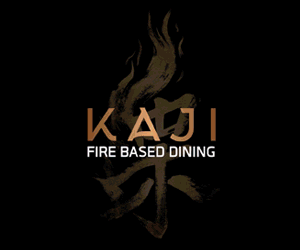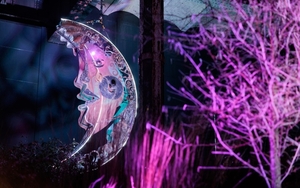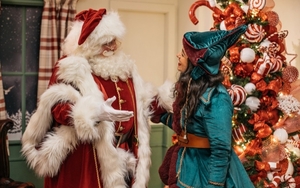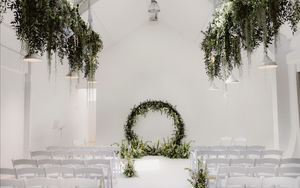David Adamson meets legendary music photographer, Jill Furmanovsky, about her Central Library exhibition and grabs an autograph
Jill Furmanovsky is one of the UK's most celebrated rock'n'roll photographers. Confidentials.com catches up with her as an exhibition of her work begins at Central Library. In a fascinating question and answer interview she reveals much about her techniques, her subjects and how photography has changed with digitalisation.
David Adamson (DA): So how does it feel to have captured an era before it disappeared?
Jill Furmanovsky (JF): You're right, that's what it is, an era. I don't like the word nostalgic, because nostalgic is wanting to go backwards, and I don't feel I want to go backwards. I just want to celebrate what was indigestible at the time, when things happen very fast and you don't have time to absorb them. Now that I'm coming towards the end of my time on Earth, I want to look at it because most of it has just been sitting in negative files. I did start Rock Archive in the hope that there might be some sort of museum for music photography and for the culture of rock and roll.
When I started Rock Archive 25 years ago, I thought, ‘There'll be a museum and then we can put it all in there’. There isn’t one, and so this exhibition is my attempt to say, ‘Look, this is just my work. Rock Archive’s got 70 or so photographers, look at this stuff. Keep it, look at it, treasure it’. Because it's like the Impressionist era, it's an era, and one that is coming to an end, if it hasn’t already. Talent and new ideas don't come to an end. The technology changes to digital and so there'll be another era but this one hasn't been digested properly and appreciated.
I suppose I just see everyone that I've photographed as a person. They’re just ordinary people in extraordinary circumstances and I understand that about them.
DA: I was looking through them earlier and the shot of Jimmy Page at Earls Court springs to mind. When you think of Jimmy Page, it is that image of the very sweaty, long curly hair, the Les Paul, with the dragon flares and everything. Did you know that it was iconic when you took it at the time? Obviously they were the biggest band in the world then. But did you think, ‘I am capturing something iconic here’?
JF: No, Absolutely not. It's one of these undigested moments. I was hustling at that time to be a rock photographer, and trying to get in. I think with Earls Court, it was the first time with that particular band, because they were so big, that we came in in convoys. So you'd get two songs and then the next two photographers would come in and then they'd get two songs because otherwise the pit would have been chock a block. I don't know which numbers I got but you either got a good one or you didn't.
You're too busy thinking, ‘Have I loaded the film right? Is the ASA correct? Have I focused it?’ Then even in the usage of the images afterwards, you process it and make some 10 by 8s and take them down to Melody Maker or whoever it was, put it on the picture editor's desk and hope they got used and you got your 50 quid fee.

DA: So it was just work then?
JF: It was work, yes. It was spectacular work, I was aware of that from the word go, but I didn't think it had much significance. It didn't seem to have much value particularly, it was just that I wanted to listen to that great music, I couldn't afford the tickets, and I wanted to take pictures more than anything. More than the music. And this was a way to combine two great loves.
DA: I guess now it's looked back on, talking about nostalgia, in the same way we do twenties Paris or the Impressionist era. It's got that closed element to it - ‘This is something from the past to be appreciated’. How much does black and white film feed into that? Does that lend it a special kind of aura that maybe colour now doesn't quite possess?
JF: Now it’s a choice actually. The Amy Winehouse picture, which is the key image in this thing, was shot on digital. I actually put a wobbly line around it - the wobbly line being like a negative line around it - because that was a crossover for me. That was 2006 and I think I got my first digital camera for Pink Floyd in 2005, and was in two minds about it. I remember taking some film of Amy as well, very little but a bit, so I put the line around but that actual image is digital and it was colour.
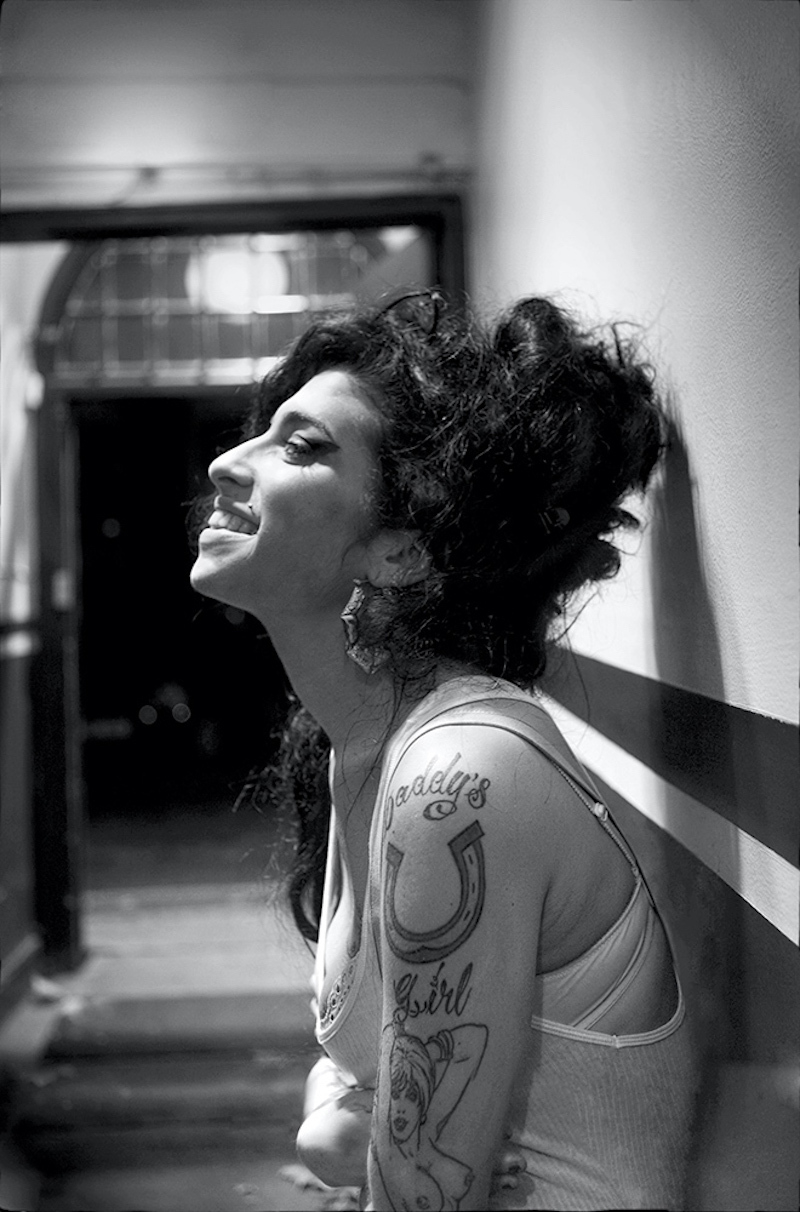
DA: Was that a conscious thing to include her in this era that, looking back, was coming to a close at that point? That you felt that she was worthy of being in this lineage of all these great artists?
JF: Well, this is the interesting thing isn't it? Who survives in the popular memory and who doesn't? Who becomes iconic and who doesn't? I could do a whole exhibition of the 80s bands I photographed that didn't survive. Also, I didn't want the exhibition to be a static thing. I'm celebrating my own work and thinking, ‘That was pretty good at the time’, and showing people work from my very early days because I know that we share that heritage, but this is a moving thing.
The faces change, some remain and some won't. In the digital era, it's more difficult to get staying power because of the turnover and the accessibility of being able to thrust yourself in front of the public. It doesn't last very long because the next one is thrusting just as hard. I’m not too sure how that's going to pan out. But certainly if an artist is very luminous, they do stand out and then if their music is really good, then you have to wait 20 or 30 years to see where it falls.
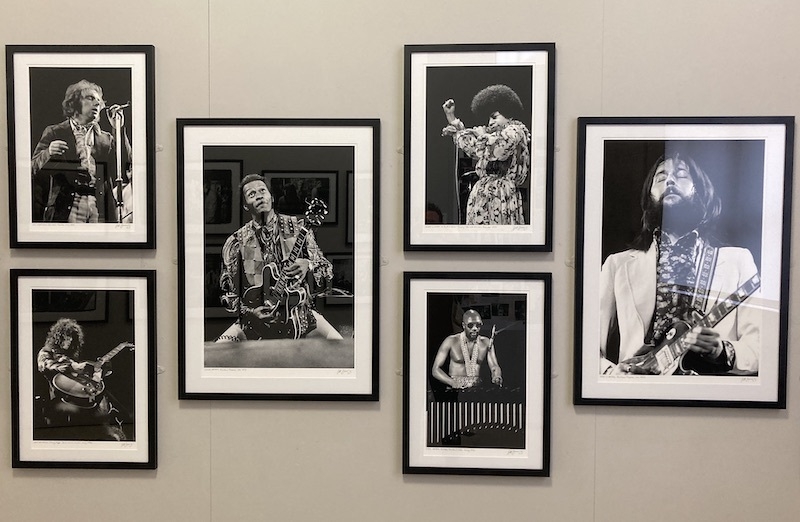
DA: What really carries through on all of these photos is how the personality of the person seems to translate to the still image. Is that a conscious effort by you? I know that perhaps with someone like Liam Gallagher it would be difficult for his personality not to emerge, but with some of the quieter subjects like David Gilmore, for instance, how do you translate their personality in a photograph like that?
JF: Well, you’ve got the shy ones and then you've got the flamboyant ones. Sometimes the shy ones are easier because the flamboyant ones have got a sort of mask, and then I want to get behind it. I suppose I just see everyone that I've photographed as a person. I'm in awe of some of these people, even the youngest talent ones. I get that same feeling of, ‘This is so spectacular’, but underneath it all, they’re just ordinary people in extraordinary circumstances and I understand that about them. And so maybe my approach to them is ‘You're very talented and all that but to me, you're just a person’.
DA: Five seconds before that photograph they were sipping a cup of tea like a mere mortal.
JF: Yeah, exactly.
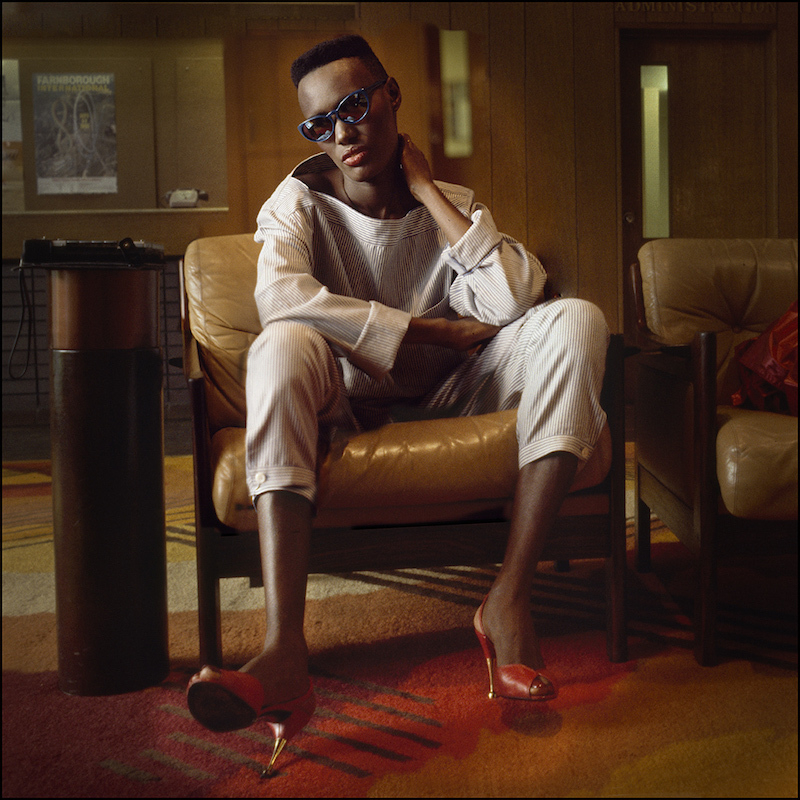
DA: So in terms of photographing women, it seems at the start of this era you were something of an outlier as a female photographer, but also in photographing women in a certain way. Did you encounter any editorial difficulty with taking photographs that didn't sexualize women at all?
JF: That's a very good point because, certainly in the 70s, it was a very sexist place. In the early days it was pretty tough for women. There was maybe the few folky types like Sandy Denny and there were a few rockers as well, but it was very male dominated. And then suddenly you get a one-off like Kate Bush come along, bang in the middle of the punk era. Johnny Rotten loved her, he thought she was great. You had somebody who's very beautiful as well and then you have to be a little bit careful because where you've got very beautiful women who they’ve got in makeup they could look like an advertisement for hair or something. Those ones that succeeded had some other quality that was not necessarily looking like a hair advertisement. I can't really get into those artists that are look as though they may also be in fashion.
DA: Because that kind of subsumes that personality that we talked about?
JF: Or it blurs it into some other area. Debbie Harry's a good example of how you can be beautiful but you can also be pretty cutting edge, which she was. She was a bit scary as well, snarly, and when you see those videos where her teeth are showing and she looks like she might bite you, she’s very pretty but you don't want to muck about with her. Kate Bush is just out there. She was just like a fairy or something, a floating ethereal thing, more like an author maybe.
DA: This style of photography that I think you've mastered is very reverent in the way that someone like TIME would photograph authors, whereas maybe musicians were seen as upstarts or not very serious. You seem to have positioned them in that in that same way.
JF: Yes, I think that's right, actually.
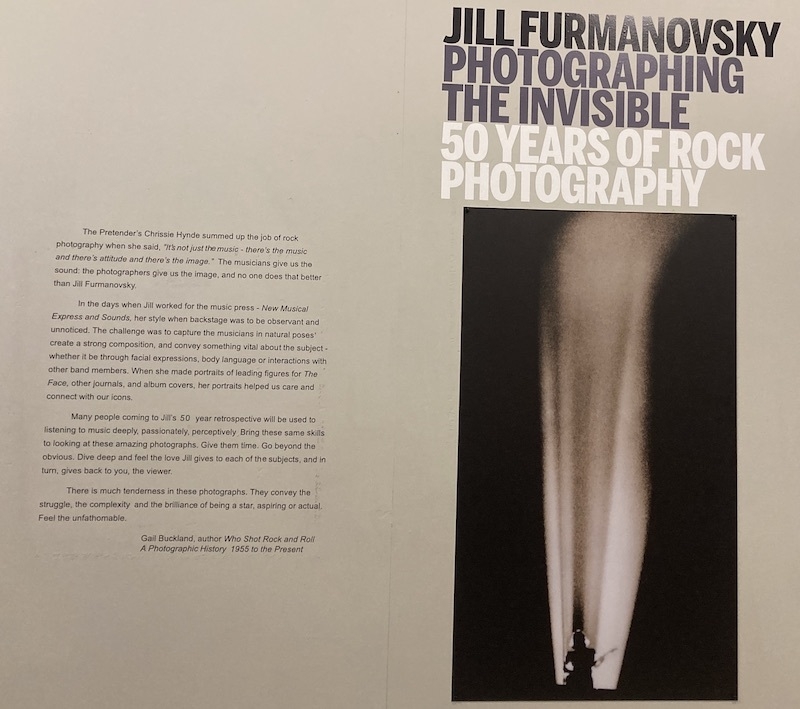
DA: So how do you feel about how now, artists command their own image through social media, especially when it comes to things like the intimacy of the road and the studio? That seems to be something they take on board themselves now. What do you think would be the effect of that ultimately?
JF: I just don't know. In a way, the openness and accessibility and the way to reach people your own age and communicate directly with them is just miraculous. But there's always a plus and a minus. It's overexposure, it's losing the intimacy. It used to be that there was time between taking a picture on a piece of film, processing it, making a print and giving it to the newspaper - at least 24 hours or something could go past, and that 24 hours can be useful. Maybe you think, ‘Actually, it’s best not to show that, it’s maybe not a good idea’. The example of that is Bob Marley and his spliff. I thought, ‘He’s had a lot of problems, I don’t want any problems with the police here’. It was still illegal to smoke marijuana in the middle of London in 1977, and I'm not going to put that in the picture because it's coming out in Sounds next week and the police might go and raid him or something - this kind of thing. It could be some intimacy that you're having with somebody and then by the next day, it's over, but it's already out on social media. So there’s no time for reflection, and that may be a drawback whilst at the same time being a plus in other ways.

DA: Do you think being that with being outside of their immediate circle and being granted access for that short period of time happening less and less now - with this self-curation of their own image - that there's less likelihood that they're going to show this vulnerability, and that actually in being that vulnerable you see something real?
JF: Yeah, I think that's spot on. Inevitably, if I take my own picture I'm going to make sure I look alright or know that I don't like myself from that angle, retouch that bit. You want an outsider, really. You want an observer, a compassionate, non-judgmental presence to reflect something back to you. You’re going through the camera to whoever's there, and if they like you they'll give you one thing and if they don't like you, they're going to give you something else.

At this point I reach into my bag and bring out my copy of Jill’s book ‘Was There Then: Oasis, A Photographic Journey’
DA: About five years ago I went in a charity shop…
JF: Oh and you got a copy of Was There Then. That's so cool. Designed by Neville Brody, who did the beautiful typography for The Face and for this exhibition. And when you open it out in the bookshop, it does that.
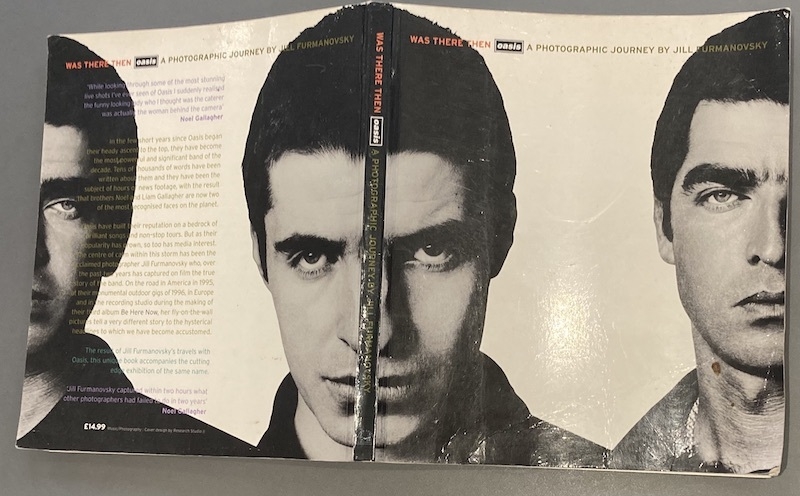
JF: Brody's a genius.
DA: Looking through this book, and then of course through the archive as well, it's almost like you were their in-house photographer and they seem to be a kind of muse for you as well.
JF: Definitely. The timing of that was just incredible. I started working with them when I was 40, and they were in their 20s, so I was old enough to be their mum - a young mum, and possibly in Noel’s case an older sister. I was very experienced as a photographer, and they were just starting out, so that was a good combination. And also they work well with women. They may feel macho in some ways, but Noel - who’s done some curation on this exhibition - pointed out that the whole band were brought up by women mainly. They've got respect for women. Their tour manager was female. Maggie Mouzakitis, she was the boss. There was somebody else ahead of me who did Oasis and then I was brought in, I think by their press guy, because he thought it’s probably good if they worked with a woman. There was me, there was Maggie, the truck driver was female, Peggy used to pop in now and again. We were the bosses, and then they were the misbehaving lads. So that creates a kind of atmosphere of its own really.
DA: So how did they feel about becoming part of your lineage of subjects, many of which were their heroes?
JF: That's why they were happy to do it. They saw my book The Moment because I’d said ‘I'm working on this book and I want to end it with you’, and they thought it was a bit of an honour to be alongside The Sex Pistols or whoever it is that they were interested in. So that elevated my position as far as they were concerned. I also think that Noel in particular had a sense that whatever was happening to them should be recorded. It's just an instinct that he had. And so he just made sure that I had the access. And also they permitted closeness, they didn't mind. Especially Liam, who, strangely enough, doesn't have much of an ego. He couldn't care less what he looked like, which is very attractive to women. You don’t want guys preening all the time, it’s not very attractive, whereas Liam was just beautiful and didn't care. He was nice to photograph because he didn't care, you could go right up to him. I put in a few new ones actually that hadn't been seen from early shoots on this exhibition. A lot of my greatest hits are not in this exhibition because I thought they'd been seen, you can go on the website and see them, but with these I tried to pull out some different ones.
DA: I’d be interested to know some of your impressions of some of these photos from Was There Then. Like this for instance..

DA: You say how beautiful he is, and I showed it my colleague earlier and said ‘Look at this handsome bastard’, and she said ‘No, look at that monobrow’.
JF laughs
JF: Well, it’s not to everyone’s taste.
DA: It seems like you went everywhere with them.
JF: I spent an intensive three year period with them up to this ’97 ‘98 period, so got to photograph them, including recording Be Here Now. When I came on board, the second album was more or less in the bag, and I didn't go into the studio with them for that second album and the first album I wasn't there for at all. That was Paul Slattery, who’s a very good photographer, and was that generation before me Oasis-wise. So I picked up the story at the end of 1994 and then followed it through to about 1998. And then after that things changed and we were in Oasis Mk2 in 2000, with Gem and Andy Bell, when Bonehead and Guigsy left.
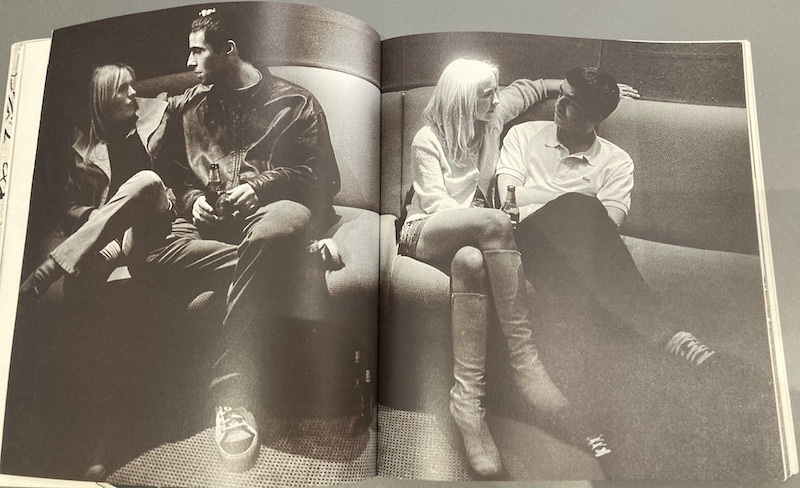
JF: This is a great shot, I really love it. It didn't get used very widely and I didn't want it to be used too widely, but I think as a photograph it didn't matter who was in it, it’s really good. It's not two pictures, it's one.
You only get two 20 pictures in your career where you think ‘I nailed that one’ and that was one of the ones I thought was a great picture.
DA: You're capturing a moment in time there, and obviously they're no longer couples as well. You see a real vulnerability to them, they look like little boys, especially Liam.
JF: Yeah. There's a photographer called Al Wertheimer who did Elvis and he said to me, ‘Elvis permitted closeness’, and now I use that term for Oasis and Liam in particular, but the artist has to permit it.
DA: An anonymous presence.
JF: Or a benign presence, because you’re not going to to sell the photo to News of the World tomorrow. It’s because it needs to be captured.
Jill then kindly signed David's copy of 'Was There Then', much to our writer's delight.
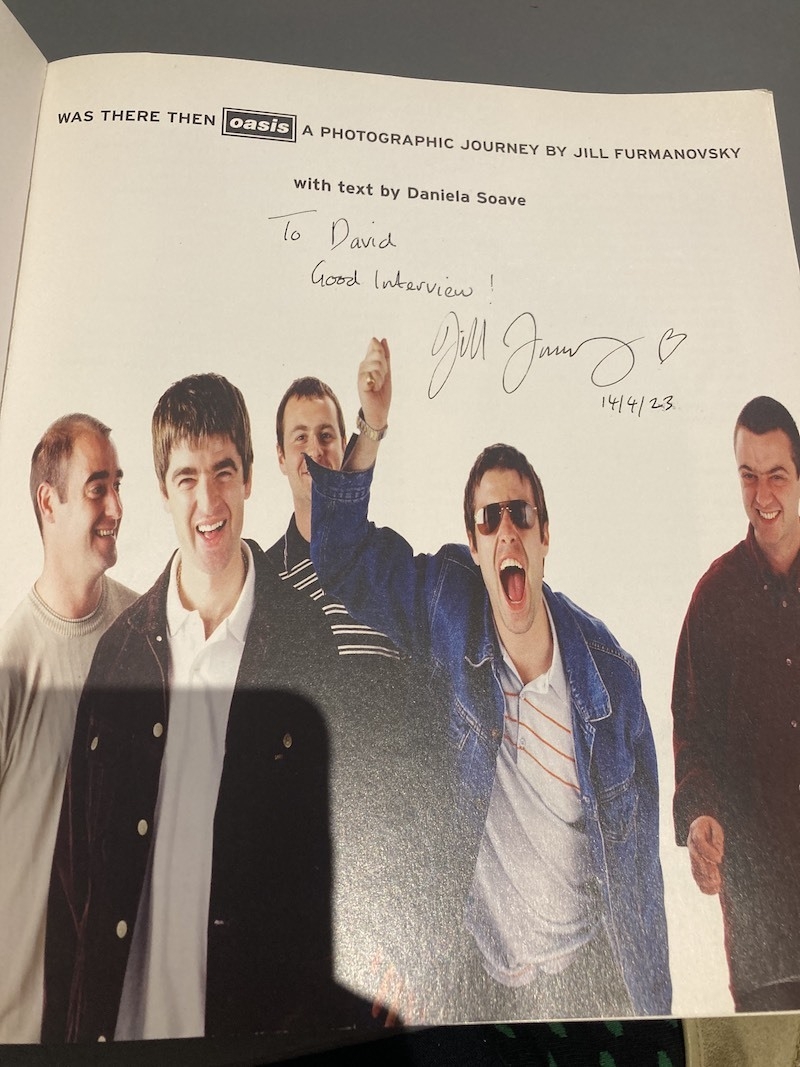
Jill Furmanovsky: Photographing the Invisible, 50 Years of Rock Photography will be displayed at Manchester Central Library until 24 June 2023
In May two special talks will take place in Manchester Central Library:
9 May: Photographing the Invisible with Jill Furmanvosky and Jon Savage. Jill speaks to the British Pop Archive’s Jon Savage about curating her retrospective and what you have to leave out.
11 May: A life in Music : Jill Furmanovsky in conversation with Mark Cooper. For the first time, former BBC Head of Music and long-time producer of Later with Jools Holland, Mark Cooper talks about a life in music with his long term friend Jill Furmanvosky.
Follow Jill on Instagram: @jillfurmanovsky
Prints of Jill's work can be purchased at http://www.rockarchive.com/
For Central Library's opening times click here







